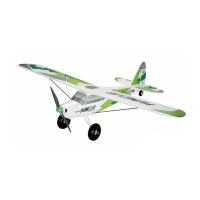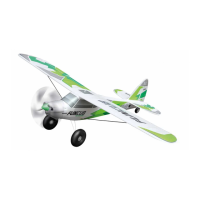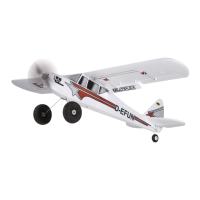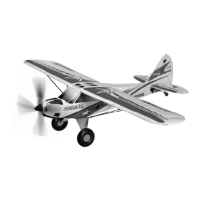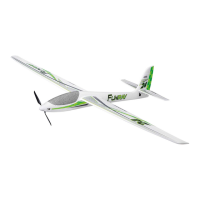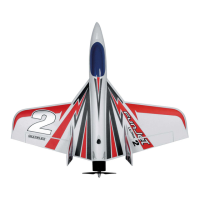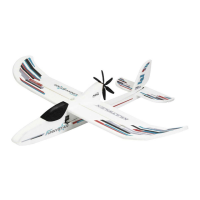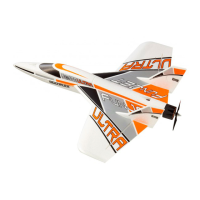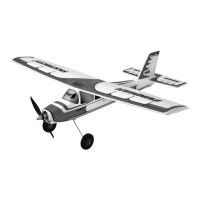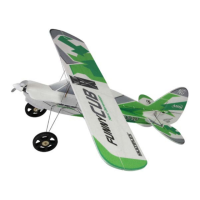14
Assembly instructions
Before assembly
Check completeness of the parts supplied using the list of parts on pages
12 and 13. We recommend using a soft, clean and at surface to ensure
the model is not damaged during assembly. Always use, unless otherwise
specically stated Zacki2 Elapor
®
CA instant adhesive to glue the model.
To ensure optimum bonding, use ne sandpaper (grain size 240-320) to
sand the contact surfaces in advance. This applies both to foam-foam and
foam-plastic bonding.
1. Assembling the tailplane
Place the tailplane on the fuselage to check the t and that it is at a
right angle to the fuselage
Fig. 1
.
If everything ts, the elevator can be
removed again. Now sand the contact surfaces slightly and then apply
adhesive to the contact surface. Now join the tailplane and the fuselage
together. Use a paper towel to wipe off any escaping adhesive. Check that
the elevator is straight and, if necessary, adjust its position
Fig. 2
.
2. Assembling the vertical tail
Proceed with the vertical tail in the same way as with the tailplane
Fig. 3
.
Initially check that it is at a right angle, sand, apply adhesive, join together
and adjust
Fig. 4
. Then stick the missing decal elements
onto the
vertical tail.
3. Assembling the undercarriage
As shown in
Fig. 5
, screw the main undercarriage
, using the
counter plate
and the 4 screws
, underneath the fuselage. Slide
a set collar
on each side of the wheel axles and tighten the grub
screws
Fig. 6
. Then install the wheels
and another set collar
on each side to ensure correct attachment. It should still be possible to
turn the wheels easily. With the tail undercarriage, initially thread the thin
side of the tubular rivet
onto the tailwheel wire
Fig. 7
. Slide on
the tailwheel
and secure it with the set collar
. The whole unit
is inserted through the hinges from below and tightened with the oval
countersunk head screws
Fig. 8
.
4. Assembling the elevator and the rudder pushrod
The roods
are hooked in according to
Fig. 8 / 9
. Place the
servos in
the center position and the rudders in the neutral position. Now tighten
the
grub screws using the included hex wrench
.
5. Installing the optional aero-tow release
The aero-tow release
can be retrotted at any time. Glue it into the
recess on the right wing provided for this purpose
Fig. 10
.
. The servo
pocket is prepared for a HS-55+. Glue the servo into place with Zacki2
ELAPOR
®
. The pushrod must be adapted to the servo arm used. Use
small at nose pliers to bend the pushrod to the desired shape. It is best
if the pushrod is hooked into the servo arm as far inside as possible. Now
move the aero-tow release to the “closed” position and cut off the excess
wire ush at the top. Use sandpaper or a le to deburr the wire at the
cutting edge.
6. Installing the receiver
The receiver is located behind the undercarriage mount.
Fig. 11
This
space is at an angle to all model axes and is therefore the ideal location
for installing a Wingstabi. First plug the servos into the receiver and then
x it into place with a piece of hook and loop tape
. Mark one of
the two green high-current connectors and its counterpart (e.g. with a felt
tip pen). This ensures there is no confusion when assembling the model.
Important: When positioning the antennas, make sure that they
cannot be shadowed by the battery, controller or cable.
7. Assembling wing struts
Assemble the wing on the fuselage by rst connecting the high-current
connectors and then positioning the wing on the fuselage; make sure
the rudders are working correctly before tightening the wing. Now use
the included multi-tool
or a suitable screwdriver to tighten the two
wing xing screws
. The created V-shape of the wing should never be
altered when adjusting the strut length
Fig. 12
. Hook the struts into the
wing. Now adjust the lower fork heads so that they can be hooked in and
out without tension. Open the fork heads using the supplied multi-tool
Fig. 13
. Once the correct length of the strut has been determined, the
lower fork heads are locked into place with the previously screwed on M2
nuts. You can also apply a drop of instant adhesive for additional security.
8. Programming the rudder deflections
Caution: Carry out all programming work with the propeller
disassembled. Optionally, the motor cables can also be disconnected.
Unintentional start-up of the motor poses a high hazard potential!!!
Set the rudder deections as follows:
Aileron: +22 mm / -12 mm
Elevator: +25 mm / -22 mm
Rudder: +28 mm / -28 mm
Landing flaps: Starting position -12 mm
Landing position -75 mm with -12 mm elevator mixed in
Important: The servos must under no circumstances run to the
stop at full deection. Also make sure that the hinges and pushrod
connectors run smoothly. An overload may damage the servos.
EN

